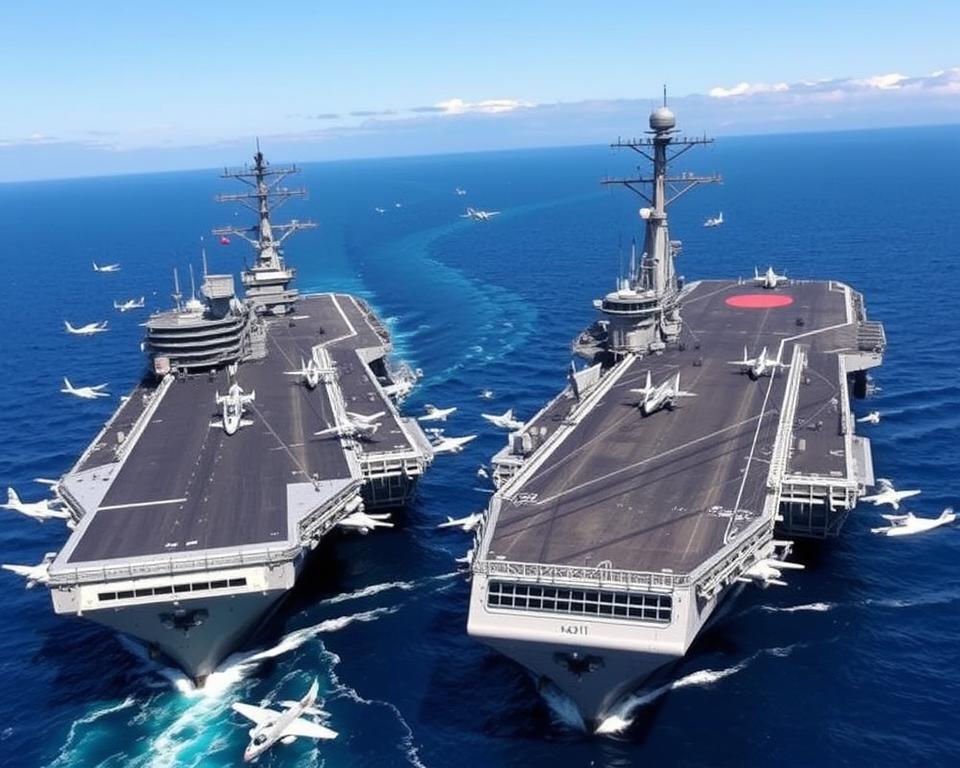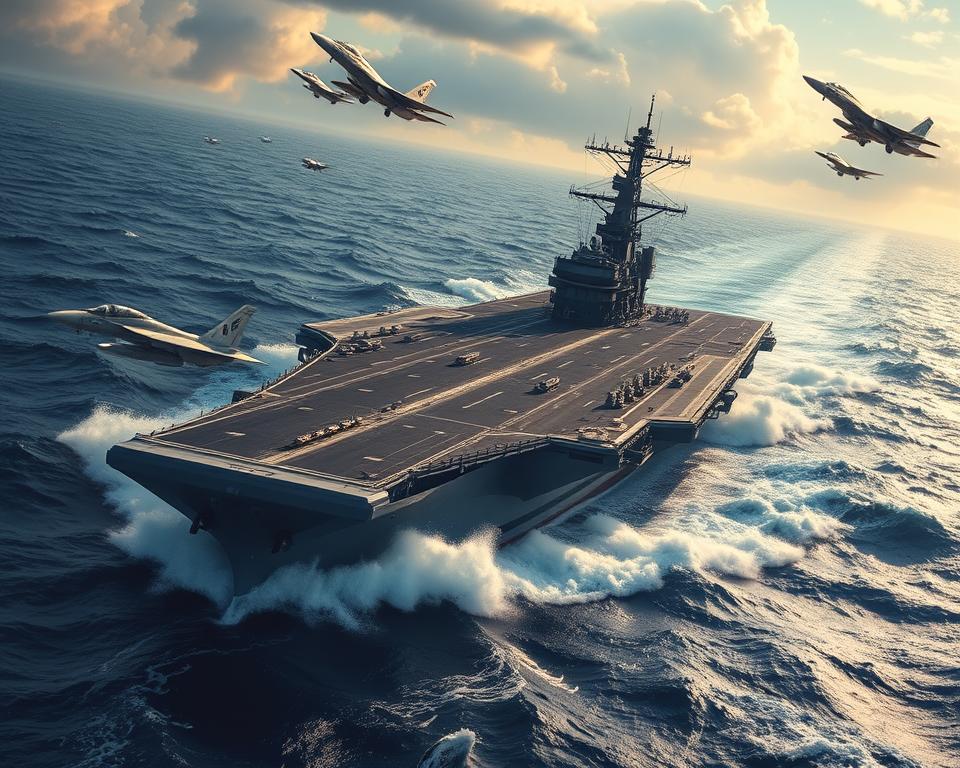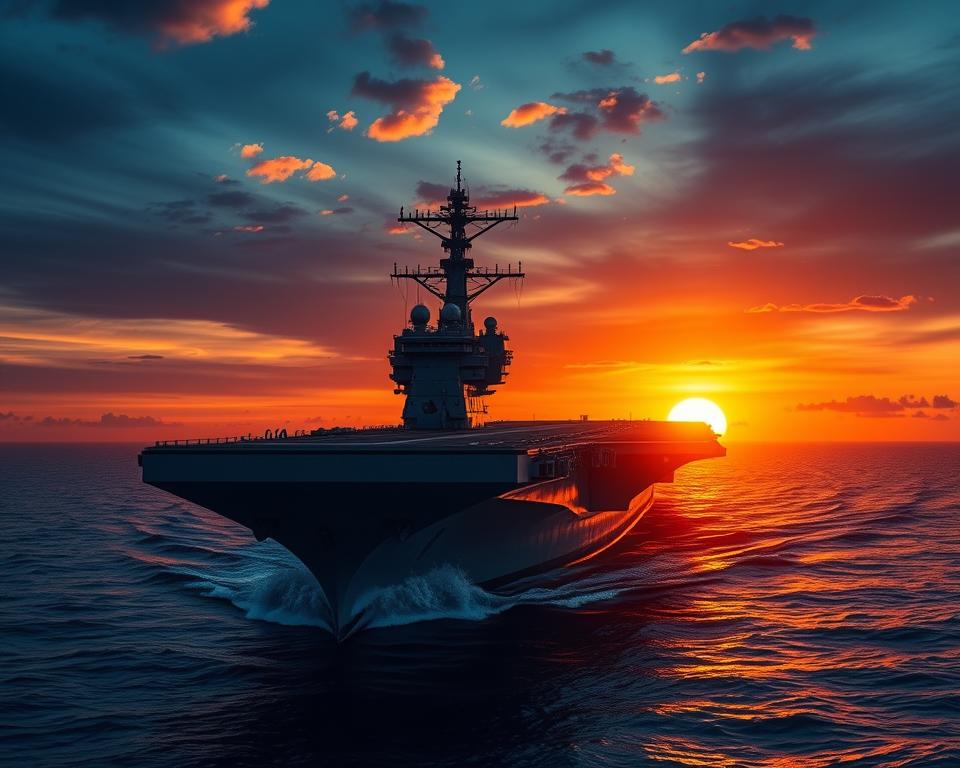The Akagi was a key aircraft carrier for the Imperial Japanese Navy in World War II. It played a big role in the Pacific Theater, taking part in early battles and meeting its end at the Battle of Midway. The Akagi’s story is tied to Japan’s rise and fall in naval power and the shift to carrier-based air power.
Read interesting things at : info-kirara
Key Takeaways
- The Akagi was a symbol of the Imperial Japanese Navy’s naval might and technological prowess.
- The Akagi’s revolutionary design and pioneering tactics were instrumental in early Pacific offensives, including the attack on Pearl Harbor.
- The Akagi’s fate at the Battle of Midway marked a turning point in the war, signaling the decline of Japan’s carrier-based air power.
- The Akagi’s legacy continues to influence modern naval strategy and the development of aircraft carrier technology.
- The Akagi’s story is a testament to the impact of a single vessel on the course of history and the evolution of naval warfare.
The Akagi: Symbol of Imperial Japan’s Naval Might
The Akagi was a symbol of Japan’s naval dominance in the Pacific during the interwar period and early stages of World War II. It was one of the most advanced aircraft carriers of its time. The Akagi showed the power and ambition of the Imperial Japanese Navy.
The Akagi’s impressive size and advanced technology made it a formidable asset in the Pacific theater. Its massive flight deck and state-of-the-art hangar facilities allowed it to launch and recover many aircraft. This made it a powerful tool for projecting naval power across vast distances.
The Akagi played a key role in battles like the attack on Pearl Harbor. This showed its capabilities and solidified its status as a symbol of Japan’s naval supremacy. The carrier’s pilots and aircrew were highly trained. They contributed to the carrier’s success in early offensives, making it a feared adversary in the Pacific skies.
The Akagi’s legacy as a flagship of the Imperial Japanese Navy has endured. Its name and image are now synonymous with Japan’s ambitious naval strategy and its quest for dominance in the Pacific.
| Characteristic | Akagi |
|---|---|
| Type | Aircraft Carrier |
| Commissioned | 1927 |
| Displacement | 36,500 tons |
| Top Speed | 31 knots |
| Aircraft Capacity | 90 planes |
“The Akagi’s mighty presence on the high seas was a testament to Japan’s ambition and naval prowess.”
The Akagi’s legacy as a symbol of Imperial Japan’s naval might continues to captivate historians and enthusiasts alike. It serves as a poignant reminder of the pivotal role played by aircraft carriers in the Pacific war.
Origins and Construction of the Akagi
The Akagi, a legendary aircraft carrier of the Imperial Japanese Navy, started as a battlecruiser. It was laid down in 1920 and was part of the Kaga-class. These ships were designed for the early 20th century’s naval trends. But, the changing nature of war soon made the Akagi a pioneering aircraft carrier.
Conversion from a Battlecruiser
In 1923, the Akagi was transformed into an aircraft carrier. It lost its heavy guns and got a full-length flight deck. It also got advanced carrier operations facilities like a big hangar and catapults.
Revolutionary Design for Carrier Operations
- The Akagi had a revolutionary design with a flush deck for smooth carrier operations.
- Its large hangar and advanced catapult system let it launch and recover a strong air wing. This made it a powerful aircraft carrier.
- The Akagi‘s design was a model for future aircraft carrier development. Its influence can be seen in later Imperial Japanese Navy carriers.
The Akagi‘s change from a battlecruiser to a leading aircraft carrier was a big step in naval warfare. It showed the rise of carrier-based air power in the Pacific.
Akagi’s Role in the Pacific Theater
The Akagi was a powerful aircraft carrier for the Imperial Japanese Navy. It played a key role in Japan’s early wins in World War II’s Pacific Theater. The Akagi’s air power was crucial in the attack on Pearl Harbor and in Japan’s expansion in the region.
Pearl Harbor and Early Offensives
On December 7, 1941, the Akagi led a surprise attack on Pearl Harbor. Its planes destroyed many American ships. This attack helped Japan win early battles in the Pacific.
After Pearl Harbor, the Akagi’s planes were in many daring missions. They helped capture the Dutch East Indies, Guam, and the Philippines. These victories showed the Akagi’s strength and Japan’s naval power.
The Battle of Midway: A Turning Point
The Battle of Midway in 1942 was a key moment in the Pacific War. The Akagi, Japan’s famous aircraft carrier, played a central role. This battle was a turning point, changing the Pacific’s power balance in favor of the United States. It also severely damaged the Akagi and the Imperial Japanese Navy.
The Akagi was one of four Japanese aircraft carriers lost at Midway. This defeat was a huge blow to Japan. It stopped the Japanese Navy’s push and let the United States take the lead.
- The Akagi‘s involvement in the Battle of Midway
- The decisive role of carrier-based air power in the battle
- The devastating loss of the Akagi and its impact on the Japanese Navy
- The strategic and tactical lessons learned from the Battle of Midway
“The Battle of Midway was a decisive and turning point in the Pacific War, as it marked the first major defeat of the Imperial Japanese Navy and the Akagi was at the heart of it.”
The Battle of Midway was a turning point in the Pacific. The Akagi‘s role in this battle made it a symbol of Japan’s naval strength and the war’s turning point.
Carrier-Based Air Power and Naval Aviation
The Akagi was a leader in carrier-based air power and naval aviation tactics. Its operations and air wing strategies were key in shaping warfare in the Pacific.
Pioneering Tactics and Strategies
The Akagi’s air wing was known for its creative tactics and strategies. Its pilots and air crews were highly skilled. They always looked for ways to outdo their foes in the Imperial Japanese Navy.
The Akagi was the first to use dive-bombing and torpedo-bombing attacks together. This tactic showed how powerful it could be. It became a key part of Japanese naval aviation at the start of the Pacific War.
The Akagi was also important in improving how to launch, recover, and coordinate aircraft. Its efficient flight deck and advanced systems helped it quickly send and bring back planes. This gave it a big advantage in battles.
The Akagi‘s tactics and strategies taught valuable lessons. These lessons helped shape naval aviation and carrier warfare in the Pacific and beyond.
Comparing the Akagi and Kaga
The Akagi and Kaga were two top aircraft carriers in the Imperial Japanese Navy during World War II. Looking closely at these ships shows us the amazing skills and features of Japan’s carrier forces back then.
Both ships were made from battlecruiser hulls, showing Japan’s smart and flexible naval strategy. The Akagi was a bit bigger, with 32,000 tons of displacement. This meant it could carry more planes, with 72 in its air group, compared to the Kaga’s 60.
| Characteristic | Akagi | Kaga |
|---|---|---|
| Displacement | 32,000 tons | 30,000 tons |
| Air Group | 72 aircraft | 60 aircraft |
| Armament | 8 × 8-inch guns, 8 × 4.7-inch guns | 8 × 8-inch guns, 8 × 4.7-inch guns |
| Speed | 31 knots | 28 knots |
Even though they had similar guns, the Akagi was faster, at 31 knots. This speed helped it move better and work with other carriers in the Imperial Japanese Navy fleet.
The Akagi and Kaga were key in the early Pacific War. They were the heart of Japan’s carrier force and took part in big battles like the attack on Pearl Harbor and the Battle of Midway. Their skills and roles in the Imperial Japanese Navy‘s early wins show how powerful these aircraft carriers were.

Life Aboard the Akagi
The Akagi was more than just a aircraft carrier in the Imperial Japanese Navy. It was also a home for its crew. Looking into their daily lives and accommodations gives us a peek into naval life during World War II.
Crew Accommodations and Routines
The Akagi was like a floating city, housing over 1,600 crew members. Each person had their own “mess” for sleeping, eating, and hanging out.
The living areas were simple but practical. Bunks were stacked high to save space. Everyone had to keep things clean and organized, following a strict routine.
| Accommodations | Daily Routines |
|---|---|
|
|
Despite cramped quarters, the Akagi‘s crew was tight-knit and disciplined. Their teamwork and toughness helped make the aircraft carrier a symbol of Imperial Japan‘s naval strength.
Akagi’s Demise and Legacy
The Akagi, a legendary aircraft carrier of the Imperial Japanese Navy, was lost at the Battle of Midway. This battle was a key moment in the Pacific War. The Akagi was hit hard by American dive-bombers, changing the war’s course.
The demise of the Akagi was a huge loss for Japan’s navy. But, its legacy remains strong. It shows Japan’s naval power and the growth of carrier warfare. The Akagi’s design and its crew’s bravery have made it a Pacific War icon.
“The Akagi’s loss was a decisive blow to the Japanese Navy, one from which it never fully recovered.”
Today, the Akagi’s impact is seen in modern aircraft carriers. Its lessons have shaped naval warfare. Its legacy will keep influencing naval strategies for years.
Though the Akagi is gone, its memory inspires many. Its story shows the Imperial Japanese Navy‘s ingenuity, courage, and resilience. It’s a reminder of their bravery, even when faced with great challenges.
Impact on Naval Warfare and Strategy
The story of the Akagi, Japan’s legendary aircraft carrier, is more than just a tale of glory and tragedy. It’s a key chapter in the evolution of naval warfare and strategy. The Akagi’s history, including its role in the attack on Pearl Harbor and its loss at the Battle of Midway, taught valuable lessons. These lessons shaped the future of maritime combat.
Lessons Learned from the Akagi
The Akagi’s successes and failures helped develop carrier-based air power and tactics. The Imperial Japanese Navy and their opponents learned important lessons. Key lessons include:
- The importance of strategic intelligence and reconnaissance in naval operations.
- The need for flexible and adaptive tactical approaches to address evolving combat situations.
- The vulnerability of large, centralized carriers to concentrated air attacks, as demonstrated by the Akagi’s downfall at Midway.
- The significance of training, discipline, and morale among carrier-based air crews in determining the outcome of key battles.
These lessons, learned in the Pacific Theater, deeply influenced naval warfare and strategic planning. They had a lasting impact on both the Japanese and their adversaries.
| Key Lesson | Significance |
|---|---|
| Importance of strategic intelligence | The Akagi’s success at Pearl Harbor showed the value of good intelligence. This became crucial for naval strategy. |
| Flexibility in tactical approaches | The Akagi’s early successes showed the need for adaptable tactics. This helped gain an advantage. |
| Vulnerability of large carriers | The Akagi’s loss at Midway showed how vulnerable large carriers are. This led to the use of more dispersed formations. |
| Importance of crew training and morale | The bravery and skill of the Akagi’s air crews were key to its early victories. This highlighted the importance of personnel development in naval aviation. |

The lessons from the Akagi‘s journey through the Pacific Theater had a lasting impact. They shaped the future of naval warfare and strategic thinking. They influenced carrier-based air power and tactics used by both sides.
Akagi in Popular Culture
The Akagi, a legendary aircraft carrier of the Imperial Japanese Navy, has left a lasting mark. It has inspired many, appearing in films, TV shows, and video games. This iconic ship has captured hearts around the world.
In the film “Tora! Tora! Tora!,” the Akagi’s role in the Pearl Harbor attack is vividly shown. The film’s focus on historical accuracy has made the Akagi a symbol of Japanese Navy’s power and innovation.
The Akagi also appears in video games like “Kantai Collection” and “World of Warships.” Players can command the Akagi in virtual naval battles. This has made the Akagi even more famous among fans of maritime history and military buffs.
The public’s ongoing interest in the Akagi shows a deep fascination with aircraft carriers and the Imperial Japanese Navy. These stories in popular culture entertain and also deepen our understanding of World War II’s Pacific theater.
“The Akagi stands as a testament to the ingenuity and ambition of the Imperial Japanese Navy, forever etched in the collective memory of those fascinated by the history of naval warfare.”
Preserving the Memory: Museums and Exhibits
Despite the tragic fate of the Akagi, efforts have been made to preserve its memory. Museums and exhibits around the world have become custodians of the artifacts and remnants of the Akagi. They allow visitors to learn about and appreciate the ship’s significant role in naval history.
Artifacts and Remnants of the Akagi
The National Museum of the Pacific War in Fredericksburg, Texas, has an impressive collection of Akagi memorabilia. It includes navigation equipment, personal belongings of the crew, and even a section of the ship’s hull. Visitors can immerse themselves in the Akagi’s history and gain a deeper understanding of the vessel’s design and capabilities.
In Japan, the Yamato Museum in Kure City houses a treasure trove of exhibits related to the Akagi and other renowned aircraft carriers of the Imperial Japanese Navy. Visitors can explore scale models, historical documents, and interactive displays that bring the Akagi’s story to life. It provides a unique opportunity to connect with this iconic warship.
| Museum | Location | Akagi-related Exhibits |
|---|---|---|
| National Museum of the Pacific War | Fredericksburg, Texas, USA | Navigation equipment, personal belongings, and a section of the ship’s hull |
| Yamato Museum | Kure City, Japan | Scale models, historical documents, and interactive displays |
These museums and exhibits serve as vital platforms for preserving the memory and legacy of the Akagi. They ensure that future generations can learn about and appreciate the influential role this aircraft carrier played in the history of naval warfare.
Conclusion
The Akagi, Japan’s legendary aircraft carrier, shows the power and dreams of the Imperial Japanese Navy in World War II. It played a key role in early Pacific battles and met its end at the Battle of Midway. Its story still fascinates those who love naval history and the growth of air power.
The Akagi was a symbol of the Navy’s tech and vision. Its design and tactics changed naval warfare. It showed how aircraft carriers became key in the Pacific. Its story teaches us about the power of military strength and the creativity of history makers.
Looking back at the Akagi, we see its lasting effect on history. It inspires many, from scholars to fans of the military. Its legacy reminds us of the importance of innovation and strategy in naval warfare. The Akagi’s story will keep teaching us, showing its impact on modern naval battles.
